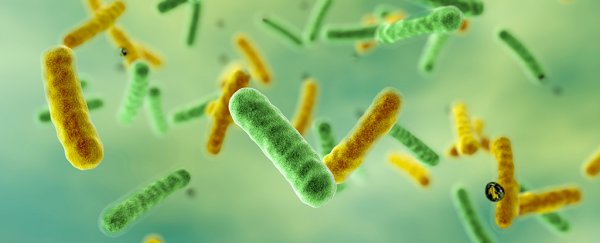Oxygen is life to animals like us. But for many species of microbe, the smallest whiff of the highly reactive element puts their delicate chemical machinery at risk of rusting up.
The photosynthesizing bacterium Chlorobium tepidum has evolved a clever way to shield its light-harvesting processes from oxygen's poisonous effects, using a quantum effect to shift its energy production line into low gear.
A study conducted by scientists from the University of Chicago and Washington University in St. Louis has shown how the bacterium throws a spanner into its quantum resonance to 'tune' its system so that it loses energy in the presence of oxygen, preventing it from wrecking its photosynthetic apparatus.
Our everyday experience of solid reality seems a million miles away from the phantom landscape of quantum effects, where an object's nature is a smear of possibility until an observation locks them into place.
Far from solid spheres clicking together, the particles making up our atoms and molecules resonate with possibility, refusing to settle until the dice of chance stack high enough for a particular reaction to become inevitable.
While this much is clear, there remain questions over how often something as complex as a living system actively exploits the finer features of quantum mechanics in the name of survival.
"Before this study, the scientific community saw quantum signatures generated in biological systems and asked the question: Were these results just a consequence of biology being built from molecules, or did they have a purpose?" explains University of Chicago chemist Greg Engel.
Evidence that quantum effects can be woven into living systems has been building for some time.
A recent study showed how changes in a magnetic field influence an electron's spin in light-sensitive proteins called cryptochromes, a phenomenon that might explain how some animals can detect our planet's magnetosphere.
Identifying a subtle nudging of quantum influence in a sensory reaction is one thing, though. Observing it at the core of an organism's survival is quite something else.
"This is the first time we are seeing biology actively exploiting quantum effects," says Engel.
As a strictly anaerobic bacterium, C. tepidum isn't keen on having oxygen run rampant through its guts. What is useful in releasing energy from glucose inside our cells destroys the apparatus for turning light into chemical bonds inside the microbe.
Key to this chain of transformative reactions is a cluster of proteins and pigments called the Fenna-Matthews-Olson (FMO) complex. It acts as a mediator between the system's light-harvesting components and the factory floor where energy is converted into chemistry.
It was initially thought that FMO relies on quantum coherence to do its work, matching the wave-like nature of particles in order to facilitate the transfer of electrons efficiently.
Later studies forced a rethink on the role of this strictly quantum phenomenon in FMO operation, claiming that, if anything, quantum coherence might actually slow the whole process down.
In this latest exploration of quantum coherence within FMO, researchers are taking into account the effect oxygen might have on the whole system.
Using an ultrafast laser spectroscopy technique to capture details on the complex's activity, the team showed how the presence of oxygen could change how energy was 'steered' from the light-harvesting components into the reaction center.
They found a pair of cysteine molecules sat at the core of the operation, acting as a trigger by releasing a proton whenever they reacted with any oxygen that happened to be present.
This lost proton directly affected the quantum mechanisms within the FMO complex, effectively shuffling energy away from areas that would otherwise be open to oxidation.
While it means the bacterium is temporarily deprived of energy, the quantum interruption forces the cell to hold its breath until it can be clear of oxygen's toxic effects.
"The simplicity of the mechanism suggests that it might be found in other photosynthetic organisms across the evolutionary landscape," says lead author Jake Higgins, a graduate student at the The University of Chicago's Department of Chemistry.
"If more organisms are able to dynamically modulate quantum mechanical couplings in their molecules to produce larger changes in physiology, there could be a whole new set of effects selected for by nature that we don't yet know about."
There could be a whole world of quantum biology just waiting to be discovered.
This research was published in PNAS.
